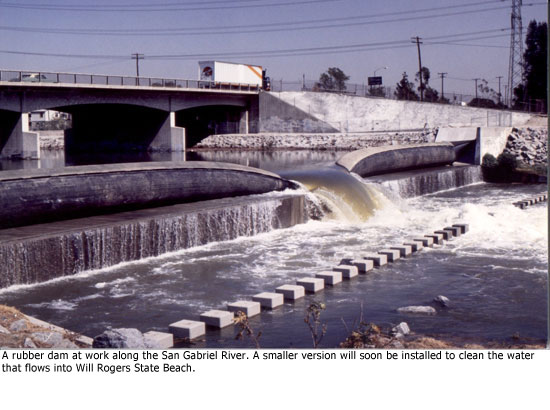A new way to dam pollution
June 23, 2010
In a bid to improve water quality at a popular beach, Los Angeles County Public Works engineers will deploy an unusual weapon: a large, inflatable rubber dam.
The device, measuring 37 feet long and 4 feet high when inflated, will be used during the dry season in the Santa Monica Canyon storm drain to keep dirty water from flowing into the ocean at Will Rogers State Beach. The result, according to Bruce Hamamoto of the Department of Public Works: “There will be less bacteria at the beach.”
The rubber dam, scheduled to be installed in 2011, will replace an existing system that sends bacteria-laden water through sewers and into the City of Los Angeles’ Hyperion treatment plant near LAX, where harmful bacteria are removed. The new system will give water officials more flexibility to increase the amount of dirty water diverted to Hyperion.
Although rubber dams have been used by the county to help manage groundwater storage, this is the first use of a large dam along the coast to fight water pollution. (A small rubber dam was installed at the new Marie Canyon facility in Malibu last year.)
The rubber dam, essentially an inch-thick inner tube, allows officials to capture dirty water that would, on occasion, breach an existing 15-inch concrete dam, built in 2003. Now, when the water gets higher, the rubber dam can be inflated up to four feet high to divert more of the flow to Hyperion. Conversely, officials can deflate the rubber dam during storms to send water directly into the ocean and avoid flooding.
The $2 million dam, approved by the Board of Supervisors last month, represents the county’s portion of a joint project with the City of Los Angeles. The city will spend $6 million to double the size of the pipes that divert water through the sewers to Hyperion.
The dam project is part of a broader county effort to improve water quality at L.A.’s beaches by bringing pollution levels below those set by state environmental regulators.
More than 3 million gallons of water flow through the Santa Monica Canyon Channel on the average “dry season” day. Much of the water comes from the irrigation of lawns and gardens across a 10,000-acre swath of the Westside.
Post 6/23/10













 405 bridge work causes a stink
405 bridge work causes a stink
